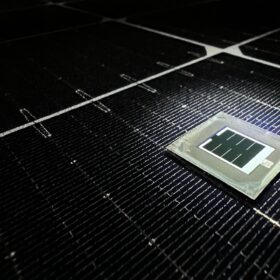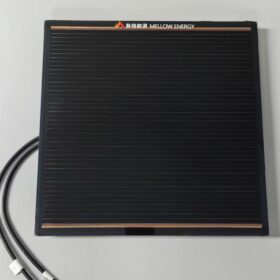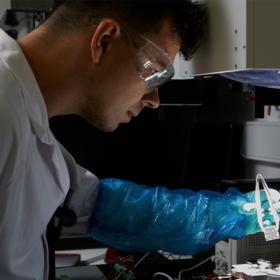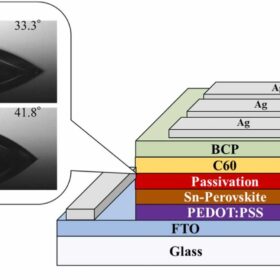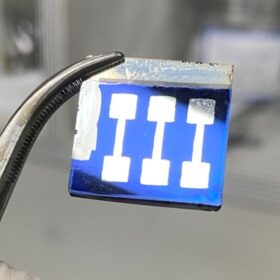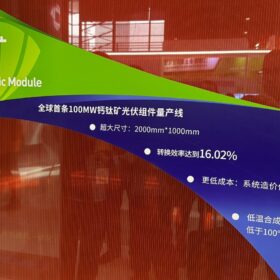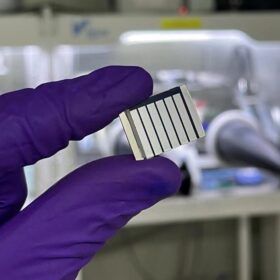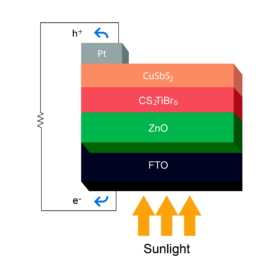Perovskite-silicon tandem solar modules must ensure degradation rate of 0.4%/year to compete with crystalline silicon
Researchers from Saudi Arabia’s King Abdullah University of Science and Technology (KAUST) investigated the commercial prospects of perovskite-silicon tandem PV technologies and found that, in order to bring them closer to market maturity, their cost should not exceed by 30% that of crystalline silicon counterparts. Their roadmap stresses the importance of reducing perovskite degradation and improving product stability.
Perovskite solar module based on new interconnection tech achieves 21.37% efficiency
Chinese solar perovskite specialist Mellow Energy and the Jinan University developed a new manufacturing process for perovskite solar modules that enables the formation of a protective layer at the interface between the perovskite absorber and the electron transport layer. This prevents the effusion of volatile components from the perovksite film.
Breakthrough for producing perovskite solar cells with AI
Researchers at RMIT University’s School of Science, Monash University and Australia’s Commonwealth Scientific and Industrial Research Organisation (CSIRO) have harnessed artificial intelligence to accelerate the design and production of perovskite solar cells.
Training AI to improve film quality in perovskite solar cells
With the aim of improving coating processes for large area thin films for high-performing perovskite solar cells, German and Swiss researchers have developed deep learning and explainable artificial intelligence (XAI) technology. The results suggest it can be used to define optimal coating process parameters more quickly and more accurately.
New passivation strategy paves the way for lead-free perovskite-silicon tandem solar cells
Scientists in Japan have developed a lead-free tin sulfide solar cell that is intended for applications in tandem perovskite-silicon PV devices. Through a new passivation technique based on the use of phenylsilane (PhSiH3) as a reducing agent, they were able to considerably increase the cell efficiency compared to a reference device with no PhSiH3 treatment.
Inverted perovskite-organic tandem solar cell achieves 23.07% efficiency via metal ion-doped absorber
A group of scientists in Korea has a hot-air technique instead of atomic layer deposition to fabricate a perovskite absorber that reportedly shows a higher film quality. They applied this film in a perovskite-organic tandem solar cell, which exhibited low open-circuit voltage losses and high efficiency levels.
GCL claims 18.04% efficiency for perovskite solar panel
The China National Institute of Metrology has certified the result. The manufacturer claims it was able to increase the panel efficiency from 16.02% to 18.04% in a few months.
Perovskite-silicon tandem cell achieves 28.9% efficiency via high bandgap top perovskite cell
A group of international researchers has developed a new perovskite-silicon solar cell design using a top perovskite PV device with an energy bandgap of 1.67 eV and a new self-assembly monolayer based on carbazole. The tandem cell achieved a higher efficiency compared to counterparts without the monolayer and passed the IEC 61215 standard thermal cycling test.
Chinese institute unveils 26.1%-efficient perovskite PV cell with new additive
The Chinese Academy of Sciences has unveiled a high-efficiency perovskite solar cell with a purported peak efficiency rating of 26.1%, by using 1-(Phenylsulfonyl)pyrrole (PSP) as an additive. The cell is third-party certified with an efficiency of 25.2%, and it maintains 92% of its original efficiency after 2,500 hours of operation.
New lead-free perovskite solar cell design promises 26.96% efficiency
Bangladeshi scientists have developed a high-efficiency perovskite solar cell with 26.96% efficiency, an open-circuit voltage of 1.0478 V, and a fill factor of 81.35%.
